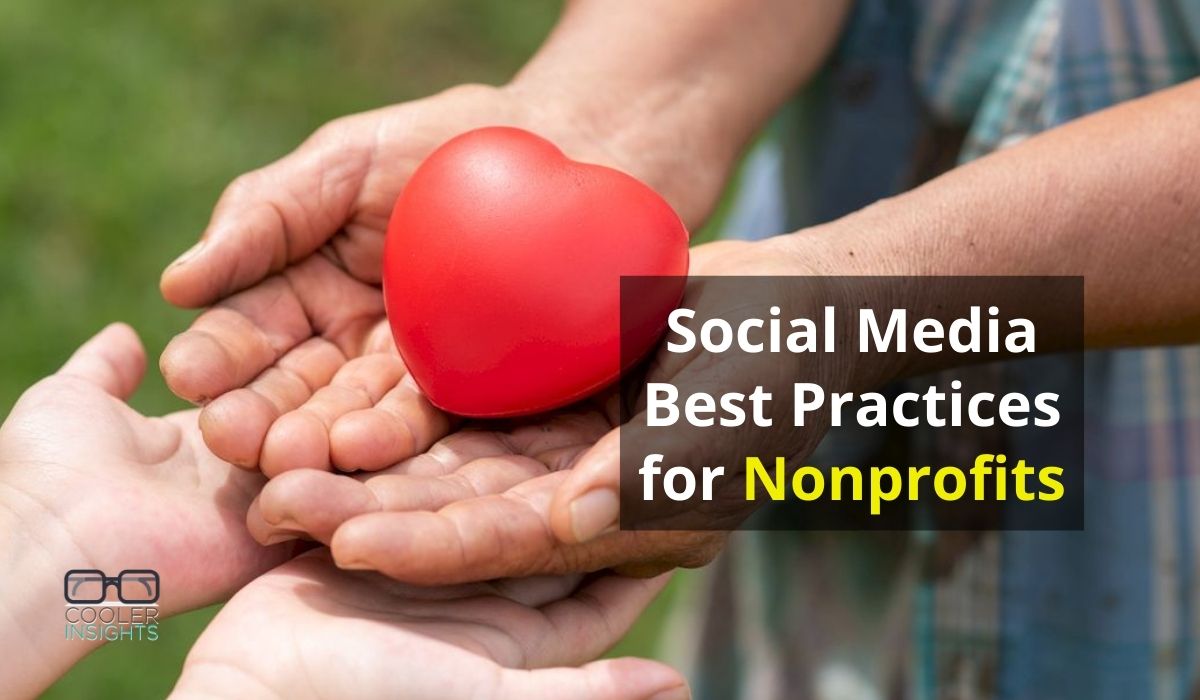
People photo created by jcomp – www.freepik.com
Have you used social media to boost awareness of your charity, Non-Governmental Organisation (NGO) or other nonprofit? Wish to generate greater traction for your online marketing efforts?
In this article, you will learn how to raise your nonprofit’s profile, improve fundraising efforts, and foster greater advocacy through social media marketing.
Before we plunge into these social media best practices, let us first look at what a nonprofit is.
What is a Nonprofit?
A nonprofit or not-for-profit organisation can be defined as an organisation which supports a specific cause or which advocates a specific point of view. Unlike for-profit organisations like companies and businesses, nonprofits aren’t set up to generate revenue—their ultimate goal is to “change the world” (or at least their immediate communities) in pursuit of a social, environmental, religious, political, scientific, or other cause.
Most nonprofit organisations are set-up as charities or Institutions of a Public Character (IPCs). While some do conduct revenue-generating activities like training, certification programmes, selling merchandise, and provision of paid services, the majority of nonprofits are largely funded through donations.
Do you know that there are 2,277 registered charities and 610 IPCs in Singapore? While we certainly have our fair share of nonprofits, the majority of them are fairly inactive on social media.
Challenges Faced by Nonprofits
As a board-member for a couple of nonprofits, I am well aware of the challenges faced by charities, NGOs, Voluntary Welfare Organisations (VWOs), societies or other nonprofits.
While some nonprofits have done exceedingly well, the majority find it difficult to sustain what they do year-after-year in view of the following:
- Need for Fundraising: Most nonprofits are poorly funded, unless they are backed by an uber-wealthy benefactor.
- Competition: With over 2,900 charities and IPCs in Singapore bidding for attention, competition in any sense of the word is keen.
- Compassion Fatigue: Yes, this is a new phenomenon caused by the endless stream of news, content and campaigns on social media channels.
- Media Fatigue: On the flip side of the same coin, nonprofits may find it increasingly difficult to attract media attention unless they have a unique news hook or are sizable enough to matter.
- Limited Manpower: Most nonprofits are run on by a skeletal crew—often, the responsibilities are shared between a full-time team, board members and volunteers.
- Shoestring Marketing Budget: This is expected given how challenging it can be to raise funds in a competitive environment—a situation which further exacerbates the challenges which charities and NGOs face.
Against this backdrop, what can nonprofits like yours do to tap on social media marketing?
Zoom in on a Distinctive Niche
First and perhaps most importantly, you need to position your nonprofit in a unique niche.
Do not aspire to be the next WWF, Red Cross, or Salvation Army. Instead, identify a specific role that your organisation can play for a specific under-served cause or community and focus on it.
Doing so will help you to stand out in a sea of me-too charities demanding attention. It’ll also help you to spin a more interesting story which can help you to beat the overwhelming consumer and media fatigue afflicting the social, environmental or other nonprofit sectors.
Case Study: Pencils of Promise
A good example of a charity with a very focused niche is Pencils of Promise. Focused on serving the educational needs of kids in underdeveloped communities around the world, its clarion call to potential givers is well defined on their website as well as their Facebook Page as shown below.
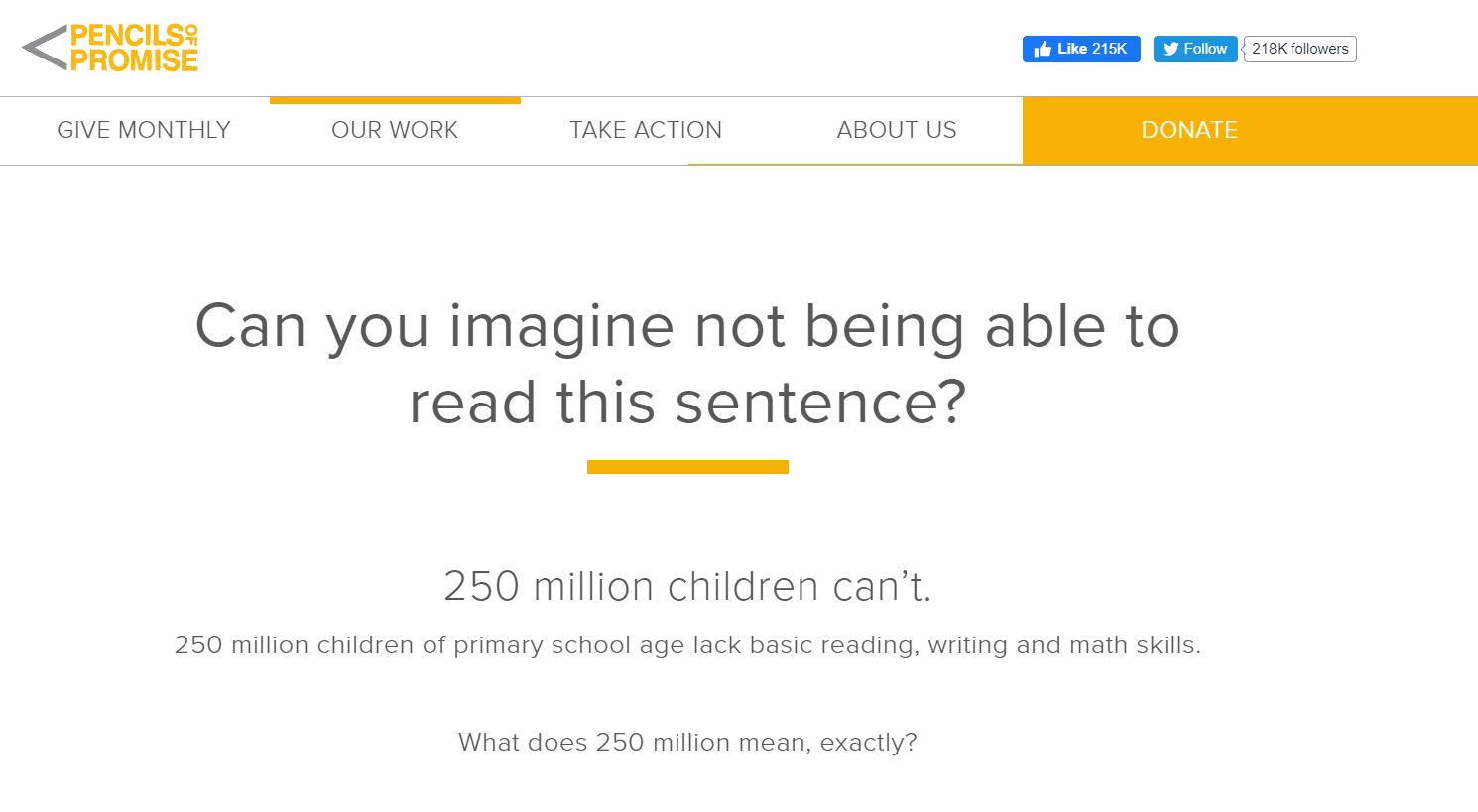
Courtesy of Pencils of Promise website
Craft Your Nonprofit’s Stories
Storytelling is par for the course. The most successful nonprofits knows the value of a good story, and its impact not only on tugging the heartstrings but opening the purse strings of potential donors.
In crafting your brand stories, consider the following in your narrative:
- The Cause/ Mission: How did your nonprofit come about? What is the bigger picture and the impact which the nonprofit hopes to achieve?
- Founder Backstory: Who are the founders of the nonprofit? What were the trigger points in their lives which motivated them to start this organisation?
- The Beneficiaries: Who are the beneficiaries of your movement? Why are they important and what difference can your movement make to them?
- Zoom in on a Protagonist: While it is useful to talk about your beneficiaries in general, what you ought to do is to zoom in on the details of 1 or 2 ‘heroes’ in your story. This is akin to the panda in WWF’s ongoing campaign, or a specific individual from the 3rd world country who will benefit from donor’s generosity.
- The Challenges/ Enemies: Any good charity or NGO needs to identify the “enemy” of their cause—this can be anything from global warming, environmental disasters, abject poverty, to problem gambling and cyber-security. Where possible, try to include some statistics to outline the gravity of the problem.
Learn more about how you can craft a good story here.
Case Study: charity: water
charity: water is a good example of a nonprofit that knows how to tap on the power of storytelling. It regularly posts mini-narratives on its Facebook page featuring what their beneficiaries from third-world countries go through, and how their work helps to provide clean drinkable water to these communities. This helped them to achieve a significant amount of success—for 2018, they funded water projects that will serve a total of 1.27 million people.
Tap Trending News and Topics
Reading the news and riding on emerging trends can be fruitful for charities, VWOs and NGOs. Using the strategy of newsjacking, you can harness the power of breaking news that relate to your topic of interest, and create a piece of content that rides on that current attention.
When doing so, do be mindful of the sensitivities surrounding the topic which you choose. While some could be fairly innocuous, others that are politically or religiously linked could be powder kegs that you should avoid.
Case Study: World Wide Fund for Nature (WWF)
Few nonprofits follow the news as closely as the WWF.
In response to the horrific and rampant bushfires in Australia, the global NGO has posted content on its Facebook page urging support for the catastrophe.

By clicking on the Facebook post, readers will be brought to a landing page highlighting the extent of the disaster and the areas that need immediate assistance as shown below.
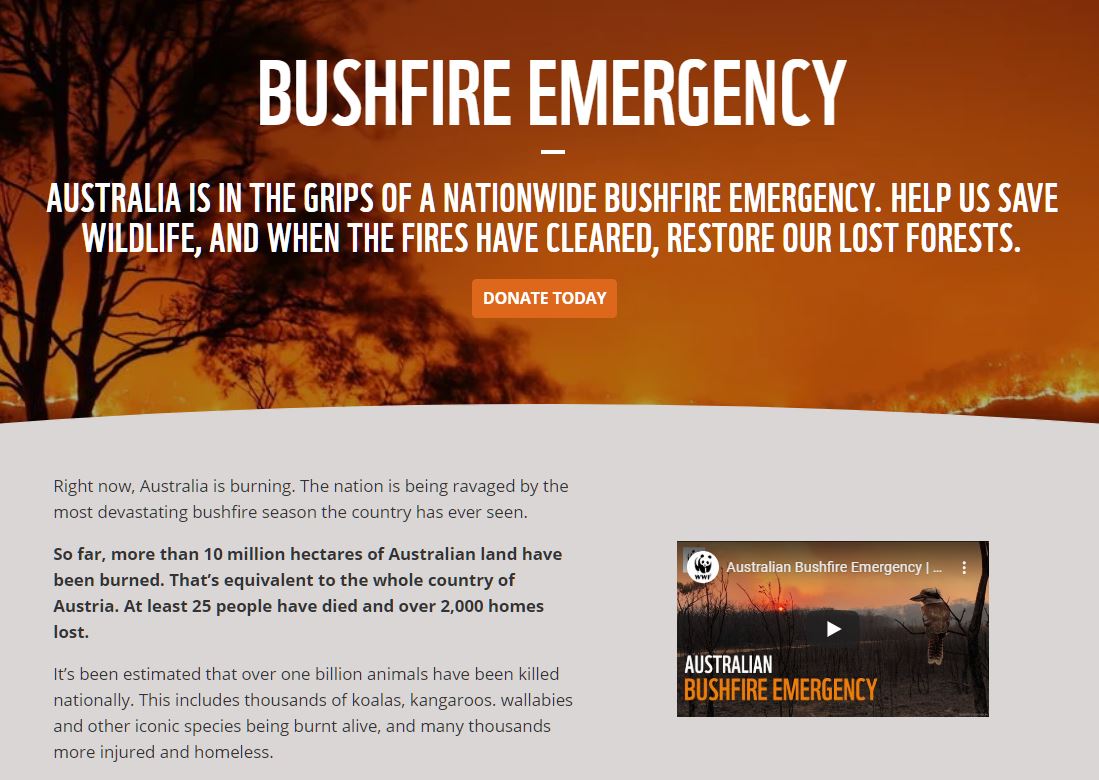
Recruit Volunteers to be Online Advocates
With social media becoming almost ubiquitous, nonprofits should consider tapping on their volunteers to spread the word.
There are various ways to do this without being too overbearing or spammy. Consider following these steps:
- Set-up a Telegram channel or an Email List and invite your volunteers to subscribe
- Let them know that you’ll be sharing your latest social posts on this channel, and that they’re encouraged to re-share them on their own social media networks if they feel moved to do so
- Create different tiers for your volunteers, and appoint leaders among them—they can be your chief advocates. These individuals should be those who are the most committed to your cause.
- Find opportunities to co-create content together with your volunteers. Better yet, train them how to use their social media channels like Instagram, Facebook, or Twitter to spread the word!
Interact with Like-Minded Influencers
Influencer engagement is a vital part of the nonprofit social media marketing strategy. However, it can be tricky trying to identify the right influencers to work with.
Here are some ways to prevent yourself from barking up the wrong influencer’s tree:
- Look at what they regularly post on, and see if there are any synergies with your cause. You can use a free tool to do research on them.
- Study their follower profiles to see if these are the target audiences for your nonprofit
- Review their posts to see if they have supported any nonprofits or charities in the past
- Use a tool like Social Blade to determine their relative strengths in social media engagement
While major influencers like the Kardashians or Beckhams could bring your charity to the next level, it may be more reasonable to target micro-influencers—these everyday folks are more likely to respond to appeals to help if they see synergy with their lifestyles.
Case Study: Singapore Kindness Movement (SKM)
The Singapore Kindness Movement has been working with various online influencers over the years. In their Be Greater campaign, they’ve worked with 17 influencers who each wore an SKM T-shirt with a customised message. This helped them to spread the message to a wide range of different audiences.
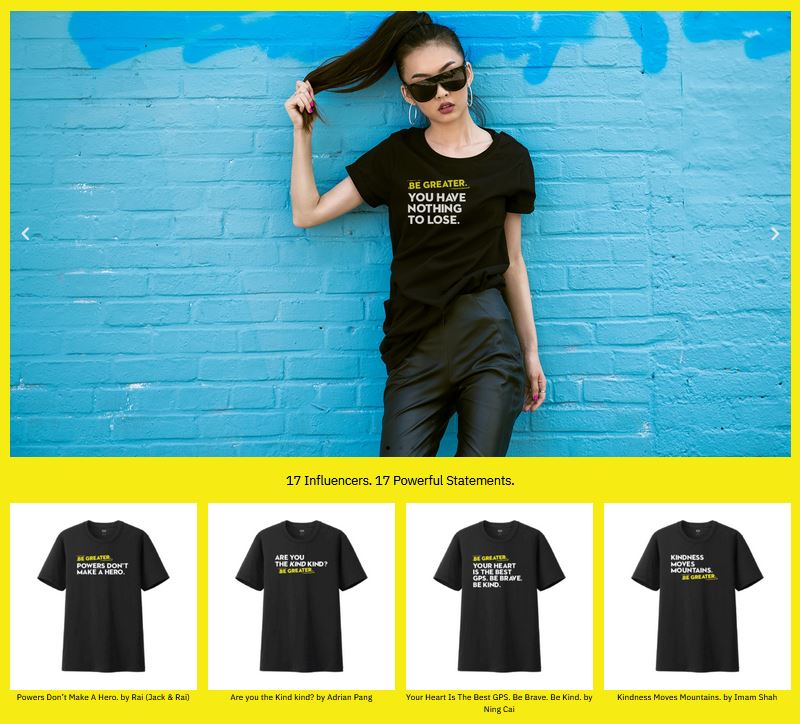
Here’s one of the Instagram posts featuring Instagram influencer Hannah Delisha.
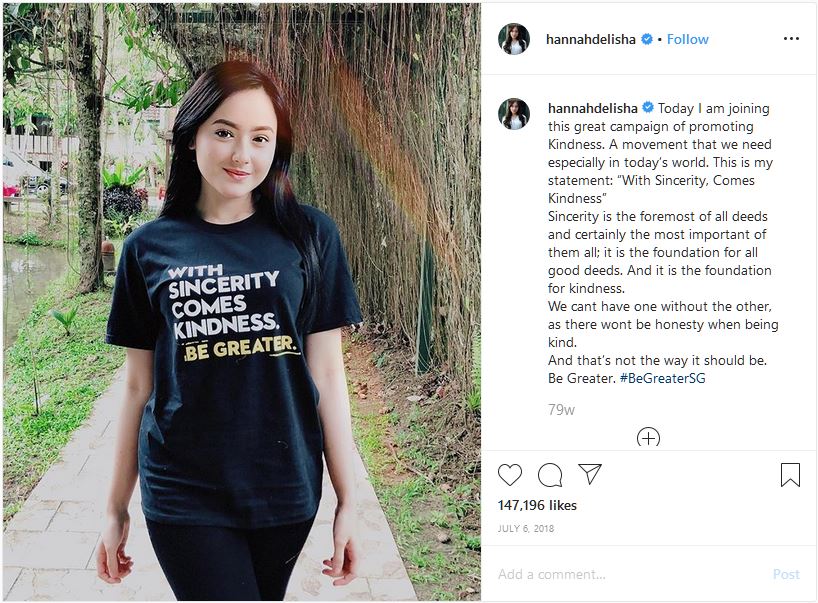
Plan Your Content Calendar
As the saying goes: fail to plan and plan to fail.
In the world of nonprofit social media marketing, developing a well-structured content calendar can help your organisation to be more systematic and productive in coming up with relevant social media content ideas.
There are several ways to plan your content calendar:
- Themes: Are there certain themes for the different days of the week? For example, Monday could be on motivational posts, Tuesdays on trending news topics, and Wednesdays on what’s happening in your organisation.
- Topics: Structure your calendar according to the types of topics that are of interest to your audience. It could include research, news items, statistics on impact, beneficiary stories, or other similar topics.
- Seasons: Look at the different festive occasions and holidays, and tie it back to your nonprofit. For example, Chinese New Year (CNY) is normally a time of feasting, and it could be a good time to share content related to minimising food waste if your charity is focused on Zero Waste habits.
Produce Attention Grabbing Videos
These days, just words alone doesn’t suffice. In an online world that is filled with content clutter, the ones that stand out not only tell a story—often, they’re presented in the form of a compelling video.
Personally, I find that interviews featuring too many talking heads can often be deadly on a mobile device. What you should do instead is to produce or curate short clips that catch and retain the attention of your audience. Do remember to include subtitles and text overlays so that the message can come out.
Case Study: World Economic Forum
Here’s an example of a well-produced short video from the World Economic Forum. Notice how it relays a message on a cause without going too heavy into hardsell?
Engage with Your Online Community
Posting content alone isn’t enough. You need to engage with your online community to keep members interested and invested in what your cause does.
Beyond responding to fans who comment on your posts, you may also want to engage proactively on other Facebook Groups or LinkedIn Groups. Or participate in a forum discussing topics that are of relevance to your nonprofit, and provide helpful advise and inputs.
Don’t Just Ask—Give Value Too
Finally, consider ways to provide value to your volunteers or donors but do it when they don’t expect it. In other words, don’t make it appear to be a quid pro quo transaction—”Here’s what you can get if you donate $10,000 to our project…”
Here are some ways to add value to your givers and volunteers:
- Tag your donors or volunteers and highlight them in your posts
- Feature benefactors in your social media posts—be specific about how their gifts have helped
- Regularly share useful tips and strategies on philanthropy
- Create special events to honor, thank and acknowledge your donors and benefactors—remember to capture videos and photos of these events and tag them
- Send a regular newsletter to sponsors and donors to keep them informed on the developments in your nonprofit
Conclusion
I hope that the above ideas and examples have been helpful for your nonprofit.
In an increasingly noisy and cluttered world, charities and NGOs need all the help that they can get. By applying these best practices in social media marketing, you’ll be better prepared to amplify your nonprofit’s online efforts to improve awareness, drive donations, and recruit volunteers.

One Comment
Comments are closed.